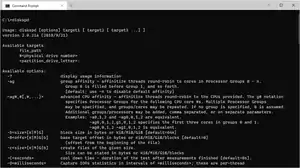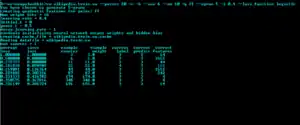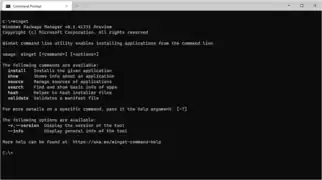Microsoft and open source
Microsoft, a technology company once known for its opposition to the open source software paradigm, turned to embrace the approach in the 2010s. From the 1970s through 2000s under CEOs Bill Gates and Steve Ballmer, Microsoft viewed the community creation and sharing of communal code, later to be known as free and open source software, as a threat to its business, and both executives spoke negatively against it. In the 2010s, as the industry turned towards cloud, embedded, and mobile computing—technologies powered by open source advances—CEO Satya Nadella led Microsoft towards open source adoption although Microsoft's traditional Windows business continued to grow throughout this period generating revenues of 26.8 billion in the third quarter of 2018, while Microsoft's Azure cloud revenues nearly doubled its revenue.[1]
Microsoft open sourced some of its code, including the .NET Framework and Visual Studio Code, and made investments in Linux development, server technology, and organizations, including the Linux Foundation and Open Source Initiative. Linux-based operating systems power the company's Azure cloud services. Microsoft acquired GitHub, the largest host for open source project infrastructure, in 2018. Microsoft is among the site's most active contributors. This acquisition lead a few projects to migrate away from GitHub.[2] This proved a short lived phenomenon because by 2019 there were over 10 million new users of GitHub.
Since 2017, Microsoft is one of the biggest open source contributors in the world,[3] measured by the number of employees actively contributing to open source projects on GitHub, the largest host of source code in the world.[4][5]
History
Initial stance on open source

The paradigm of freely sharing computer source code—a practice known as open source—traces back to the earliest commercial computers, whose user groups shared code to reduce duplicate work and costs.[6] Following an antitrust suit that forced the unbundling of IBM's hardware and software, a proprietary software industry grew throughout the 1970s, in which companies sought to protect their software products. The technology company Microsoft was founded in this period and has long been an embodiment of the proprietary paradigm and its tension with open source practices, well before the terms "free software" or "open source" were coined. Within a year of founding Microsoft, Bill Gates wrote an open letter that positioned the hobbyist act of copying software as a form of theft.[7]
Microsoft successfully expanded in personal computer and enterprise server markets through the 1990s, partially on the strength of the company's marketing strategies.[8] By the late 1990s, Microsoft came to view the growing open source movement as a threat to their revenue and platform. Internal strategy memos from this period, known as the Halloween documents, describe the company's potential approaches to stopping open source momentum. One strategy was "embrace-extend-extinguish", in which Microsoft would adopt standard technology, add proprietary extensions, and upon establishing a customer base, would lock consumers into the proprietary extension to assert a monopoly of the space. The memos also acknowledged open source as a methodology capable of meeting or exceeding proprietary development methodology. Microsoft downplayed these memos as the opinions of an individual employee and not Microsoft's official position.[9]
While many major companies worked with open source software in the 2000s,[10] the decade was also marked by a "perennial war" between Microsoft and open source in which Microsoft continued to view open source as a scourge on its business[11] and developed a reputation as the archenemy of the free and open source movement.[12] Microsoft CEO Steve Ballmer likened Linux to a kind of cancer on intellectual property. Microsoft sued Lindows, a Linux operating system that could run Microsoft Windows applications, as a trademark violation. The court rejected the claim and after Microsoft purchased its trademark, the software changed its name to Linspire.[11]
In 2002, Microsoft began experimenting with 'shared source', including the Shared Source Common Language Infrastructure, the core of .NET Framework.[13]
2000s
In April 2004, Windows Installer XML (WiX) was the first Microsoft project to be released under an open-source license,[14] the Common Public License.[15] Initially hosted on SourceForge,[16] it was also the first Microsoft project to be hosted externally.
In June 2004, for the first time Microsoft was represented with a booth at LinuxTag, a free software exposition, held annually in Germany.[17] LinuxTag claims to be Europe's largest exhibition for open source software. In September 2004, Microsoft released its FlexWiki, making its source code available on SourceForge.[18] The engine is open source, also licensed under the Common Public License. FlexWiki was the third Microsoft project to be distributed via SourceForge, after WiX and Windows Template Library (WTL).
In 2005, Microsoft released the F# programming language under the Apache License 2.0.[13]
In 2006 Microsoft launched its CodePlex open source code hosting site, to provide hosting for open-source developers targeting Microsoft platforms. Microsoft also ported PHP to Windows under PHP License and partnered with Novell to improve open source interoperability in 2006.[13] Microsoft partnered with and commissioned Vertigo Software in 2006 to create Family.Show, a free and open-source genealogy program, as a reference application for Microsoft's latest UI technology and software deployment mechanism at the time, Windows Presentation Foundation and ClickOnce.[19][20][21] The source code has been published on CodePlex and is licensed under the Microsoft Public License.
In June 2007, Tom Hanrahan, former Director of Engineering at the Linux Foundation, became Microsoft's Director of Linux Interoperability.[22][23] The Open Source Initiative approved the Microsoft Public License (MS-PL) and Microsoft Reciprocal License (MS-RL) in 2007.[13] Microsoft open sourced IronRuby, IronPython, and xUnit.net under MS-PL in 2007.[13]
In 2008, Microsoft joined the Apache Software Foundation[24] and co-founded the Open Web Foundation with Google, Facebook, Sun, IBM, Apache, and others.[13] Also in 2008, Microsoft began distributing the open source jQuery JavaScript library together with the Visual Studio development environment for use within the ASP.NET AJAX and ASP.NET MVC frameworks.[25][26]
When Microsoft released Hyper-V in 2008, SUSE Linux Enterprise Server became the first non-Windows operating system officially supported on Hyper-V. Microsoft and Novell signed an agreement to work on interoperability two years earlier.[27]
Microsoft first began contributing to the Linux kernel in 2009.[13]
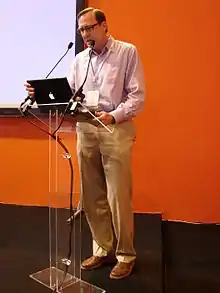
In 2010, Microsoft Research and Wikipedia joined forces to launch WikiBhasha, an open-source multi-lingual content creation tool for the online encyclopedia.[28] Based on customer feedback, Microsoft relicensed IronRuby, IronPython, and the Dynamic Language Runtime (DLR) under Apache License 2.0 in July 2010.[29]
Microsoft signed the Joomla contributor agreement and started upstreaming improvements in 2010.[13]
2010s
In 2011, Microsoft started contributing code to the Samba project. The same year, Microsoft also ported Node.js to Windows, upstreaming the code under Apache License 2.0.[13]
After acquiring Skype in 2011, Microsoft continued maintaining the Skype Linux client.[13]
Microsoft became a partner with LinuxTag for their 2011 event and also sponsored LinuxTag 2012.[30][31]
In 2012, Microsoft began hosting Linux virtual machines in the Azure cloud computing service and CodePlex introduced git support.[13] The company also ported Apache Hadoop to Windows, upstreaming the code under MIT License.[13]
Also, ASP.NET, ASP.NET MVC, ASP.NET Razor, ASP.NET Web API, Reactive extensions, and IL2JS (an IL to JavaScript compiler) were released under Apache License 2.0.[13]
The TypeScript programming language was released under Apache License 2.0 in 2012. It was the first Microsoft project hosted on GitHub.[13]
In 2013, Microsoft relicensed the xUnit.net unit testing tool for the .NET Framework under Apache License 2.0 and transferred it to the Outercurve Foundation.[13] Also in 2013, Microsoft added Git support to Visual Studio and Team Foundation Server using libgit2, the most widely deployed version of Git. The company is dedicating engineering hours to help further develop libgit2 and working with GitHub and other community programmers who devote time to the software.[32]
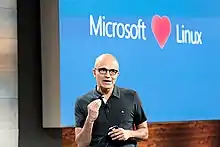
In 2014, Satya Nadella was named the new CEO of Microsoft. Microsoft began to adopt open source into its core business. In contrast to Ballmer's stance, Nadella presented a slide that read, "Microsoft loves Linux".[12] At the time of the acquisition of GitHub, Nadella said of Microsoft, "We are all in on open source." As the industry trended towards cloud, embedded, and mobile computing, Microsoft turned to open source to stay apace in these open source dominated fields. Microsoft's adoption of open source included several surprising turns.
.jpg.webp)
In 2014, the company opened the source of its .NET Framework to promote its software ecosystem and stimulate cross-platform development. Microsoft also started contributing to the OpenJDK the same year.[13] The Wireless Display Adapter, released in 2014, was Microsoft's first hardware device to use embedded Linux.[13]
In 2015, Microsoft co-founded the Node.js Foundation[33] and joined the R Foundation. The same year, Microsoft also open sourced Matter Center, Microsoft's legal practice management software and also Chakra, the Microsoft Edge JavaScript engine at the time.[13] Also in 2015, Microsoft released Windows 10 with native support for the open-source AllJoyn framework, which means that any Windows 10 device can control any AllJoyn-aware Internet of Things (IoT) device in the network.[34] Microsoft has been developing AllJoyn support and contributing code upstream since 2014.[13]
Microsoft opened the keynote speech at All Things Open in 2015 by stating that:
Microsoft's approach to open today is: Enable, integrate, release, and contribute.
In August 2015, Microsoft released WinObjC, also known as Windows Bridge for iOS, an open-source middleware toolkit that allows iOS apps developed in Objective-C to be ported to Windows 10.[36][37][38] On November 18, 2015, Visual Studio Code was released under the Expat License and its source code posted to GitHub.[39]
In January 2016, Microsoft became Gold Sponsor of SCALE 14x – the fourteenth annual Southern California Linux Expo, a major convention.[40]
When Microsoft acquired Xamarin and LinkedIn in 2016, it relicensed the Mono framework under MIT License and continued maintaining the Kafka stream-processing software platform as open source.[13] Also in 2016, Microsoft introduced the Windows Subsystem for Linux, which lets Linux applications run on the Windows operating system. The company invested in Linux server technology and Linux development to promote cross-platform compatibility and collaboration with open source companies and communities, culminating with Microsoft's platinum sponsorship of the Linux Foundation and seat on its Board of Directors.[41]
Microsoft released SQL Server and the now open source PowerShell for Linux.[13] Also, Microsoft began porting Sysinternals tools, including ProcDump and ProcMon, to Linux.[42]
In March 2016, Ballmer changed his stance on Linux, saying that he supports his successor Satya Nadella's open source commitments. He maintained that his comments in 2001 were right at the time but that times have changed.[43][44]
Commentators have noted the adoption of open source and the change of strategy at Microsoft:[45]
The company has become an enthusiastic supporter of Linux and of open source and a very active member of many important projects.
The BitFunnel search engine indexing algorithm and various components of the Microsoft Bing search engine were made open source by Microsoft in 2016.[47][48]
Microsoft joined the Open Source Initiative, the Cloud Native Computing Foundation, and the MariaDB Foundation in 2017.[13] The Open Source Initiative, formerly a target of Microsoft, used the occasion of Microsoft's sponsorship as a milestone for open source software's widespread acceptance.
The Debian-based SONiC network operating system was open sourced by Microsoft in 2017.[49]
Also the same year, the Windows development was moved to Git and Microsoft open sourced the Git Virtual File System (GVFS) developed for that purpose.[50][51] Other contributions to Git include a number of performance improvements useful when working with large repositories.[52][53] Microsoft opened the Microsoft Store to open source applications and gave the keynote speech at the Open Source Summit North America 2017 in Los Angeles.[13]
Microsoft became Platinum Sponsor and delivered the keynote of the 2018 Southern California Linux Expo – the largest community-run open-source and free software conference in North America.[54][55]
Microsoft developed Linux-based operating systems for use with its Azure cloud services. Azure Cloud Switch supports the Azure infrastructure and is based on open source and proprietary technology, and Azure Sphere powers Internet of things devices. As part of its announcement, Microsoft acknowledged Linux's role in small devices where the full Windows operating system would be unnecessary.[55]
In 2018, Microsoft joined the Open Invention Network[56] and cross-licensed 60,000 patents with the open source community.[57][58]

.jpeg.webp)
Also in 2018, Microsoft acquired GitHub, the largest host for open source project infrastructure. Microsoft is among the site's most active contributors and the site hosts the source code for Microsoft's Visual Studio Code and .NET runtime system. The company, though, has received some criticism for only providing limited returns to the Linux community, since the GPL license lets Microsoft modify Linux source code for internal use without sharing those changes.[61] In 2019, Microsoft's Windows Subsystem for Linux 2 transitioned from an emulated Linux kernel to a full Linux kernel within a virtual machine, improving processor performance manifold. In-keeping with the GPL open source license, Microsoft will submit its kernel improvements for accommodation into the master, public release.[62]
In 2018, Microsoft included OpenSSH, tar, and curl commands in Windows.[63][64] Also, Microsoft released Windows Calculator as open source under MIT License on GitHub.[65]
Microsoft added support for the open source Python programming language to Power BI in August 2018.[66]
In 2019, Microsoft released Windows Terminal, PowerToys, and the Microsoft C++ Standard Library as open source[13] and transitioned its Edge browser to use the open source Chromium as the basis.[67]
After publishing exFAT as an open specification, Microsoft contributed the patents to the Open Invention Network (OIN), and started upstreaming the device driver to the Linux kernel.[13]
At Build 2019, Microsoft announced that it is open-sourcing its Quantum Development Kit, including its Q# compilers and simulators.[68]
In December 2019, Microsoft released Microsoft Teams for Linux. This marked the first time Microsoft released an Office app for the Linux operating system. The app is available in native packages in .deb and .rpm formats.[69] Also in December 2019, after JS Foundation and Node.js Foundation merged to form OpenJS Foundation, Microsoft contributed the popular cross-platform desktop application development tool Electron to OpenJS Foundation.[70][71]
2020s
Project Verona, a memory-safe research programming language, was open sourced in January 2020.[72][73]
In 2020, Microsoft open sourced the Java extension for Microsoft SQL Server,[13] MsQuic (a Windows NT kernel library for the QUIC general-purpose transport layer network protocol),[74] Project Petridish, a neural architecture search algorithm for deep learning,[75] and the Fluid Framework for building distributed, real-time collaborative web applications.[76] Microsoft also released the Linux-based Azure Sphere operating system.[13]
In March 2020, Microsoft acquired npm, the open source Node package manager. It is the world’s largest software registry with more than 1.3 million packages that have 75 billion downloads a month.[77][78]
Also in March 2020, Microsoft together with researchers and leaders from the Allen Institute for AI, the Chan Zuckerberg Initiative, the Georgetown University's Center for Security and Emerging Technhology, and the National Library of Medicine released CORD-19, a public dataset of academic articles about COVID-19 and research related to the COVID-19 pandemic.[79] The dataset is created through the use of text mining of the current research literature.[80][81]
After exploring different alternative options and talking with various well-known commercial and open source package manager teams including Chocolatey, Scoop, Ninite and others such as AppGet, Npackd and the PowerShell based OneGet package manager-manager, Microsoft decided to develop and release the open source Windows Package Manager in 2020.[82]
Microsoft was one of the silver sponsors for the X.Org Developer’s Conference 2020 (XDC2020). Microsoft had multiple developers presenting on the opening day.[83]
In September 2020, Microsoft released the Surface Duo, an Android-based smartphone with a Linux kernel.[84] The same month, Microsoft released OneFuzz, a self-hosted fuzzing-as-a-service platform that automates the detection of software bugs.[85] It supports Windows and Linux.[86]
Microsoft is a major contributor to the Chromium project with the highest percentage of all non-Google contributors coming from Microsoft (35.2%). The company has contributed 29.4% of all non-Google commits to the source code in 2020.[87]
In February 2021, Microsoft made the source code for its Extensible Storage Engine (ESE) available on GitHub under MIT License.[88] Also in February 2021, Microsoft, together with four other founding companies (AWS, Huawei, Google, and Mozilla) formed the Rust Foundation as an independent non-profit organization to steward the open source Rust programming language and ecosystem.[89][90]
Support of open source organizations
Microsoft is either founding member, joining member, contributing member, and/or sponsor of a number of open source related organizations and initiatives. Examples include:
- .NET Foundation[91]
- Alliance for Open Media[92]
- Apache Software Foundation[13]
- Cloud Native Computing Foundation[93]
- CodePlex Foundation, later known as Outercurve Foundation[13]
- Confidential Computing Consortium[94]
- Eclipse Foundation[95]
- F# Software Foundation[96]
- Hyperledger[97]
- Linux Foundation[13]
- MariaDB Foundation[13]
- Node.js Foundation[13]
- OpenAPI Initiative[98]
- OpenBMC[99]
- OpenChain[100]
- Open Compute Project[101]
- Open Connectivity Foundation[102]
- Open Container Initiative[103]
- Open Invention Network[104]
- OpenJS Foundation[105]
- Open Source Initiative[13]
- Open Source Security Foundation[106]
- Open Web Foundation[13]
- Outreachy[107]
- R Consortium[108]
- R Foundation[13]
- Rust Foundation[109]
- Unified Patents Open Source Zone[13]
Selected products
- .NET – Managed code software framework for Windows, Linux, and macOS operating systems[41]
- .NET Bio – Bioinformatics and genomics library created to enable simple loading, saving and analysis of biological data
- .NET Compiler Platform (Roslyn) – Compilers and code analysis APIs for C# and Visual Basic .NET programming languages
- .NET Gadgeteer – Rapid-prototyping standard for building small electronic devices
- .NET MAUI – A cross-platform UI toolkit
- .NET Micro Framework – .NET Framework platform for resource-constrained devices
- AirSim – Simulator for drones, cars and other objects, built as a platform for AI research
- Allegiance – Multiplayer online game providing a mix of real-time strategy and player piloted space combat gameplay
- ASP.NET
- ASP.NET AJAX
- ASP.NET Core
- ASP.NET MVC
- ASP.NET Razor
- ASP.NET Web Forms
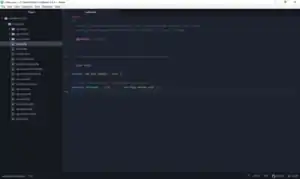
- Atom – Text and source code editor for macOS, Linux, and Microsoft Windows
- BitFunnel – A signature-based search engine
- Blazor – Web framework that enables developers to create web apps using C# and HTML
- Bosque – Functional programming language[110]
- C++/WinRT – C++ library for Microsoft's Windows Runtime platform, designed to provide access to modern Windows APIs
- C# – General-purpose, multi-paradigm programming language encompassing strong typing, lexically scoped, imperative, declarative, functional, generic, object-oriented (class-based), and component-oriented programming disciplines
- ChakraCore – JavaScript engine
- ChronoZoom – Project that visualizes time on the broadest possible scale from the Big Bang to the present day
- CLR Profiler – Memory profiler for the .NET Framework
- Conference XP – Video conferencing platform
- Dafny – Imperative compiled language that targets C# and supports formal specification through preconditions, postconditions, loop invariants and loop variants
- DeepSpeed – Deep learning optimization library for PyTorch
- Detours – C++ library for intercepting, monitoring and instrumenting binary functions on Microsoft Windows
- DiskSpd – Command-line tool for storage benchmarking that generates a variety of requests against computer files, partitions or storage devices
- Dynamic Language Runtime – Runtime that runs on top of the CLR and provides computer language services for dynamic languages
- F* – Functional programming language inspired by ML and aimed at program verification
- F# – General purpose, strongly typed, multi-paradigm programming language that encompasses functional, imperative, and object-oriented programming methods
- File Manager – File manager for Microsoft Windows
- Fluid Framework, a platform for real-time collaboration across applications[111][112]
- FourQlib – Reference implementation of the FourQ elliptic curve
- GW-BASIC – Dialect of the BASIC programming language
- Microsoft C++ Standard Library – Implementation of the C++ Standard Library (also known as the STL)[113]
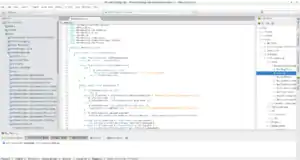
- MonoDevelop – Integrated development environment for Linux, macOS, and Windows
- MSBuild – Build tool set for managed code as well as native C++ code
- MsQuic – Implementation of the IETF QUIC protocol
- Neural Network Intelligence – An AutoML toolkit
- npm – Package manager for the JavaScript programming language
- Open Live Writer – Desktop blogging application
- Open Management Infrastructure – CIM management server
- Open XML SDK – set of managed code libraries to create and manipulate Office Open XML files programmatically
- Orleans – Cross-platform software framework for building scalable and robust distributed applications based on the .NET Framework
- P – Programming language for asynchronous event-driven programming and the IoT
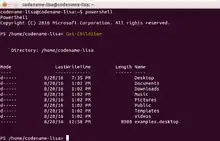
- PowerShell – Command-line shell and scripting language[114]
- Process Monitor – Tool that monitors and displays in real-time all file system activity
- ProcDump – Command-line application for creating crash dumps during a CPU spike[115]
- Project Mu – UEFI core used in Microsoft Surface and Hyper-V products
- Project Verona – Experimental memory-safe research programming language
- PowerToys for Windows 10 – System utilities for power users
- RecursiveExtractor – An archive file extraction library written in C#
- Sandcastle – Documentation generator
- StyleCop – Static code analysis tool that checks C# code for conformance to recommended coding styles and a subset of the .NET Framework design guidelines
- TypeScript – Programming language similar to JavaScript, among the most popular on GitHub[116]
- U-Prove – Cross-platform technology and accompanying SDK for user-centric identity management
- vcpkg – Cross-platform package manager used to simplify the acquisition and installation of third-party libraries
- VFS for Git – Virtual file system extension to the Git version control system
- Visual Basic .NET – Multi-paradigm, object-oriented programming language
- Visual Studio Code – Source code editor and debugger for Windows, Linux and macOS,[61] and GitHub's top open source project[116]
- VoTT (Visual Object Tagging Tool) – Electron app for image annotation and labeling
- Vowpal Wabbit – online interactive machine learning system library and program
- WikiBhasha – Multi-lingual content creation application for the Wikipedia online encyclopedia
- Windows Calculator – Software calculator[117][118]
- Windows Communication Foundation – runtime and a set of APIs for building connected, service-oriented applications
- Windows Console – Terminal emulator
- Windows Driver Frameworks – Tools and libraries that aid in the creation of device drivers for Microsoft Windows
- Windows Forms – Graphical user interface (GUI) class library
- Windows Package Manager – Package manager for Windows 10
- Windows Presentation Foundation – Graphical subsystem (similar to WinForms) for rendering user interfaces in Windows-based applications
- Windows Template Library – Object-oriented C++ template library for Win32 development
- Windows Terminal – Terminal emulator[119][120]
- Windows UI Library – Set of UI controls and features for the Universal Windows Platform (UWP)
- WinJS – JavaScript library for cross-platform app development
- WinObjC – Middleware toolkit that allows iOS apps developed in Objective-C to be ported to Windows 10
- WiX (Windows Installer XML Toolset) – Toolset for building Windows Installer packages from XML
- WorldWide Telescope – Astronomy software
- XML Notepad – XML editor
- XSP – Standalone web server written in C# that hosts ASP.NET for Unix-like operating systems
- xUnit.net – Unit testing tool for the .NET Framework
- Z3 Theorem Prover – Cross-platform satisfiability modulo theories (SMT) solver
See also
References
- Bright, Peter (April 26, 2018). "Even Windows revenue is up in Microsoft's $26.8 billion 3Q18". Ars Technica. Retrieved December 18, 2019.
- "GitHub rivals gain from Microsoft acquisition but it's no mass exodus, yet". ZDNet. May 6, 2019.
- Asay, Matt (October 30, 2017). "Why Microsoft and Google are now leading the open source revolution". TechRepublic. Retrieved April 21, 2019.
- "Microsoft may be the world's largest open source contributor, but developers don't care--yet". TechRepublic.
- Asay, Matt (February 7, 2018). "Who really contributes to open source". InfoWorld.
- Radits 2019, pp. 13–14.
- Radits 2019, pp. 17–18.
- Radits 2019, pp. 27–28.
- Radits 2019, p. 27.
- Radits 2019, p. 30.
- Radits 2019, p. 31.
- Radits 2019, p. 32.
- Barnes, Hayden (May 23, 2020). "Microsoft and Open Source: An unofficial timeline". boxofcables.dev. Retrieved October 18, 2020.
- Mensching, Rob (August 14, 2012). "Outercurve Foundation and WiX toolset together, at last". RobMensching.com /Blog. Retrieved February 16, 2014.
- Mensching, Rob (August 20, 2012). "The WiX toolset license". Retrieved February 16, 2014.
- Mensching, Rob (April 5, 2004). "Windows Installer XML (WiX) toolset has released as Open Source on SourceForge.net". RobMensching.com /Blog. Retrieved February 16, 2014.
- LinuxTag 2004 Ausstellerliste
- "FlexWiki: Microsofts Third Open Software Project", eWeek, September 28, 2004, retrieved April 5, 2012
- Tim Sneath : Announcing Family.Show 2.0 - July 17, 2007 MSDN Blogs
- Tim Sneath : Announcing Family.Show v3 – Our WPF Reference Application - February 23, 2009, MSDN Blogs
- "Vertigo Software: I See Dead People with WPF" – via channel9.msdn.com.
- Thurston, Richard (June 11, 2007). "Microsoft appoints Linux interoperability chief". ZDNet.
- Krill, Paul (June 8, 2007). "Microsoft names Linux interop director". InfoWorld.
- "Microsoft Joins Apache Software Foundation -- Redmondmag.com". Redmondmag.
- Resig, John (September 28, 2008). "jQuery, Microsoft, and Nokia". jQuery Blog. jQuery. Retrieved January 29, 2009.
- Guthrie, Scott (September 28, 2008). "jQuery and Microsoft". ScottGu's Blog. Retrieved April 15, 2019.
- Branscombe, Mary (December 2, 2020). "What is Microsoft doing with Linux? Everything you need to know about its plans for open source". TechRepublic. Retrieved December 6, 2020.
- "Write wikis in any language with new multilingual content creation tool" (Relaxnews story), The Independent, 20 October 2010. Retrieved 10 December 2010.
- Foley, Mary Jo (July 19, 2010). "Microsoft puts IronPython, IronRuby under an Apache license". ZDNet.
- "Microsoft: The Unlikely Sponsor Of Linux - Phoronix". www.phoronix.com.
- "LinuxTag 2012 Gathers Linux Stakeholders In Berlin - Phoronix". www.phoronix.com.
- Jackson, Joab (January 30, 2013). "Microsoft embraces open-source Git for development tools". CIO.
- Microsoft moves, with others, to help create the Node.js Foundation
- Kaelin, Mark (June 17, 2015). "Windows 10 supports AllJoyn making the Internet of Things possible". TechRepublic. Retrieved December 5, 2020.
- Vaughan-Nichols, Steven J. "Microsoft's Mark Russinovich to Linux faithful: Send us your resumes". ZDNet.
- Hachman, Mark (August 6, 2015). "Microsoft releases iOS-to-Windows app maker Windows Bridge to open source". PC World. IDG. Retrieved October 9, 2015.
- Chester, Brandon (April 29, 2015). "Microsoft Demonstrates Android and iOS Applications Running On Windows 10". Anandtech. Purch Inc. Retrieved October 9, 2015.
- Protalinski, Emil (May 1, 2015). "Everything you need to know about porting Android and iOS apps to Windows 10". VentureBeat. Retrieved October 9, 2015.
- "Visual Studio now supports debugging Linux apps; Code editor now open source". Ars Technica. Retrieved November 18, 2015.
- "SCALE 14x | SCALE 14x". www.socallinuxexpo.org.
- Radits 2019, p. 33.
- Cimpanu, Catalin (November 5, 2018). "Microsoft working on porting Sysinternals to Linux". ZDNet. CBS Interactive. Retrieved November 5, 2018.
- "Ballmer: Linux No Longer A Cancer - InformationWeek".
- "Steve Ballmer: Linux Is No Longer 'A Cancer'". March 11, 2016.
- Vaughan-Nichols, Steven J. "Linux and open source have won, get over it". ZDNet.
- Vaughan-Nichols, Steven J. (November 28, 2016). "Open source has won, and Microsoft has surrendered". Computerworld.
- Yegulalp, Serdar (September 6, 2016). "Microsoft open-sources Bing components for fast code compilation". InfoWorld.
- Verma, Arpit (September 7, 2016). "Microsoft Open Sources Major Components Of Bing Search Engine, Here's Why It Matters". Fossbytes. Retrieved June 12, 2020.
- Cooney, Michael (October 8, 2020). "Meet SONiC, the new NOS (definitely not the same as the old NOS)". NETWORKWORLD.
- "Scaling Git (and some back story)". Brian Harry's Blog. February 3, 2017.
- "How Microsoft Solved Git's Problem with Large Repositories". InfoQ.
- "Microsoft's Performance Contributions to Git in 2017". Azure DevOps Blog. January 11, 2018.
- "Git Merge 2019: A Recap". www.welcometothejungle.com.
- "SCALE 16x | 16x". www.socallinuxexpo.org.
- Radits 2019, p. 34.
- Vaughan-Nichols, Steven J. (October 10, 2018). "Microsoft open-sources its patent portfolio". ZDNet. Retrieved April 21, 2019.
- Vaughan-Nichols, Steven J. "What does Microsoft joining the Open Invention Network mean for you?". ZDNet.
- Gartenberg, Chaim (October 10, 2018). "Microsoft makes its 60,000 patents open source to help Linux". The Verge. Retrieved April 21, 2019.
- "Michelle Noorali: Helping Users and Developers Consume Open Source". August 2, 2018.
- "Featured Speakers - LinuxCon + ContainerCon + CloudOpen China 2018".
- Radits 2019, p. 35.
- Bright, Peter (May 6, 2019). "Windows 10 will soon ship with a full, open source, GPLed Linux kernel". Ars Technica. Retrieved May 7, 2019.
- "OpenSSH for Windows Update". October 19, 2015. Retrieved October 18, 2020.
- "Tar and Curl Come to Windows!". January 18, 2018. Retrieved November 29, 2020.
- Foley, Mary Jo (March 6, 2019). "Microsoft is open-sourcing Windows Calculator on GitHub". ZDNet. Retrieved October 18, 2020.
- Yegulalp, Serdar (August 22, 2018). "Microsoft adds Python support to Power BI". InfoWorld.
- Warren, Tom (May 6, 2019). "Inside Microsoft's surprise decision to work with Google on its Edge browser". The Verge. Retrieved May 7, 2019.
- "Microsoft is open-sourcing its Quantum Development Kit". May 6, 2019.
- Warren, Tom (December 10, 2019). "Microsoft's first Office app arrives on Linux". The Verge.
- "Electron Desktop JavaScript Framework Finds a New Home". InfoQ.
- "Electron joins the OpenJS Foundation". December 11, 2019.
- Jones, Luke (January 17, 2020). "Microsoft's Rust-Based Project Verona Reaches Open Source on GitHub". WinBuzzer.
- Tung, Liam. "Microsoft opens up Rust-inspired Project Verona programming language on GitHub". ZDNet.
- Cimpanu, Catalin. "Microsoft open-sources in-house library for handling QUIC connections". ZDNet.
- "Microsoft Open-Sources Project Petridish for Deep-Learning Optimization". InfoQ.
- Tung, Liam (September 10, 2020). "Microsoft's new Fluid Framework: Now it's open-sourced on GitHub". ZDNet. Retrieved September 20, 2020.
- Prakash, Abhishek. "With npm, Microsoft Now Owns the Largest Software Registry in the World".
- "npm is joining GitHub". March 16, 2020.
- Microsoft help create 29,000 article COVID-19 Open Research Dataset to help AI save us
- "Call to Action to the Tech Community on New Machine Readable COVID-19 Dataset". The White House. Retrieved October 13, 2020.
- "NLM Leverages Data, Text Mining to Sharpen COVID-19 Research Databases". governmentciomedia.com. Retrieved October 13, 2020.
- "Windows Package Manager Preview". Retrieved November 29, 2020.
- "Microsoft Has A Large Presence At This Year's X.Org Conference - Phoronix". www.phoronix.com.
- Warren, Tom (August 13, 2020). "Microsoft Surface Duo Arrives on September 10th for $1399". TheVerge.
- "Microsoft: Windows 10 is hardened with these fuzzing security tools – now they're open source". ZDNet. September 15, 2020.
- "Microsoft open-sources fuzzing test framework". InfoWorld. September 17, 2020.
- "Google gets web allies by letting outsiders help build Chrome's foundation". Retrieved November 23, 2020.
- Speed, Richard (February 1, 2021). "Microsoft's Extensible Storage Engine (JET Blue) source code arrives on GitHub – sadly comments not included". The Register.
- "Rust Foundation". foundation.rust-lang.org. February 8, 2021. Retrieved February 9, 2021.
- "Mozilla Welcomes the Rust Foundation". Mozilla Blog. February 9, 2021. Retrieved February 9, 2021.
- Lardinois, Frederic (April 3, 2014). "Microsoft Launches .NET Foundation To Foster The .NET Open Source Ecosystem". TechCrunch. Retrieved October 18, 2020.
- "About". Alliance for Open Media.
- "Members". Cloud Native Computing Foundation.
- "Members".
- Guindon, Christopher. "Explore Our Members | The Eclipse Foundation". www.eclipse.org.
- "F# Foundation: Taking Microsoft's F# Language to a Higher Ground (eWeek)". Retrieved October 18, 2020.
- "Supporting Members".
- "Current Members".
- "Home". OpenBMC.
- "Home". OpenChain.
- "Open Compute Project". Open Compute Project.
- "OCF Membership List".
- "Open Container Initiative - Open Container Initiative". opencontainers.org.
- "United States Archives".
- "Members".
- "Google, Microsoft, GitHub, and Others Join the Open Source Security Foundation". InfoQ.
- "Outreachy | Internships Supporting Diversity in Tech". www.outreachy.org.
- Machlis, Sharon. "Esri joins the R Consortium". Computerworld. Retrieved October 18, 2020.
- "Rust Foundation formed to manage namesake language". Neowin. Retrieved February 8, 2021.
- Krill, Paul (April 18, 2019). "Microsoft aims for simplicity with Bosque programming language". InfoWorld. Retrieved April 22, 2019.
- Tung, Liam (September 10, 2020). "Microsoft's new Fluid Framework: Now it's open-sourced on GitHub". ZDNet. Retrieved September 20, 2020.
- Warren, Tom (May 19, 2020). "Microsoft's new Fluid Office document is Google Docs on steroids". The Verge. Retrieved May 20, 2020.
- "Open Sourcing MSVC's STL". C++ Team Blog. September 16, 2019.
- "What is PowerShell? - PowerShell". docs.microsoft.com.
- "ProcDump - Monitor CPU/processes - Windows CMD - SS64.com". ss64.com.
- Chan, Rosalie (November 9, 2019). "The 10 most popular programming languages, according to the Microsoft-owned GitHub". Business Insider. Retrieved November 28, 2019.
- Warren, Tom (March 6, 2019). "Microsoft open-sources its Windows calculator on GitHub". The Verge. Retrieved April 21, 2019.
- Archambault, Michael (March 6, 2019). "Microsoft Continues Open-Source Effort, Releases Calculator Code". Digital Trends. Retrieved April 21, 2019.
- Bowden, Zac (May 19, 2020). "Microsoft's open source Windows Terminal app reaches stable release". Windows Central. Retrieved May 20, 2020.
- Warren, Tom (May 6, 2019). "Microsoft unveils Windows Terminal, a new command line app for Windows". The Verge. Retrieved May 20, 2020.
Bibliography
- Radits, Markus (January 25, 2019). A Business Ecology Perspective on Community-Driven Open Source: The Case of the Free and Open Source Content Management System Joomla. Linköping University Electronic Press. ISBN 978-91-7685-305-4.
Further reading
- Bright, Peter (May 10, 2019). "Microsoft: The open source company". Ars Technica. Retrieved May 11, 2019.
- Hayes, Frank (March 19, 2001). "The Microsoft Way". Computerworld. 35 (12). p. 78. ISSN 0010-4841.
- Nadella, Satya (2017). Hit Refresh: The Quest to Rediscover Microsoft's Soul and Imagine a Better Future for Everyone. Harper Business. ISBN 978-0062652508.
- Ovide, Shira (April 16, 2012). "Microsoft Dips Further Into Open-Source Software". Wall Street Journal. ISSN 0099-9660.
- Vaughan-Nichols, Steven J. (October 29, 2014). "Why Microsoft loves Linux". ZDNet. Retrieved April 21, 2019.
- Vaughan-Nichols, Steven J. (January 26, 2015). "Microsoft: The open-source company". ZDNet. Retrieved December 31, 2019.
- Vaughan-Nichols, Steven J. (June 9, 2016). "Why Microsoft is turning into an open-source company". ZDNet. Retrieved April 21, 2019.
- Vaughan-Nichols, Steven J. (December 30, 2019). "Linux and open-source rules: 2019's five biggest stories show why". ZDNet. Retrieved December 31, 2019.
- Warren, Tom (April 29, 2019). "How Microsoft learned from the past to redesign its future". The Verge. Retrieved April 30, 2019.
- Warren, Tom (May 18, 2020). "Microsoft: we were wrong about open source". The Verge. Retrieved May 20, 2020.



